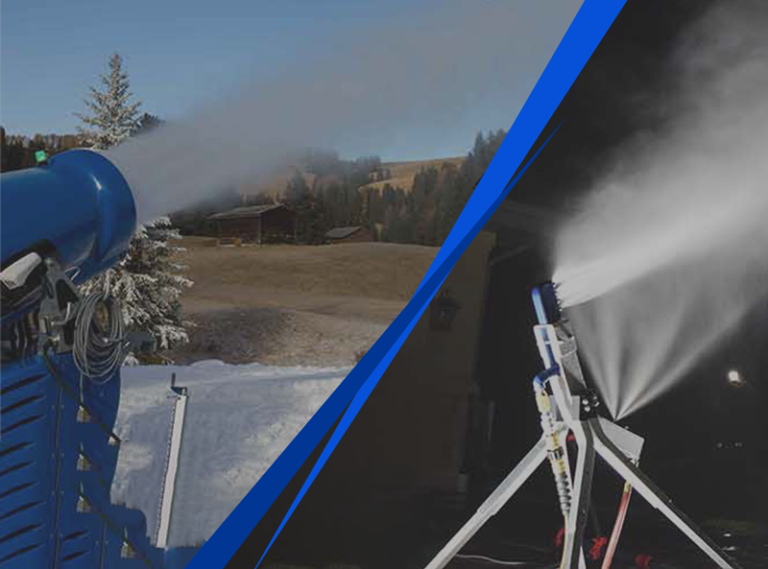Free Shipping | Fast Delivery | 30 Day Returns ON ALL Snow Guns!
Free Shipping | Fast Delivery | 30 Day Returns ON ALL Snow Guns!

The biggest difference between commercial and residential snowmaking is scale or snow output. Commercial snow guns run huge amounts of water through each snow gun to make enormous amounts of snow needed at winter resorts. Commercial snow guns have a wide range, but will typically run between 50-100 GPM (gallons per minute) of water flow per snow gun. These winter resorts have large reservoirs (lakes) dedicated to snowmaking. During the season, water is pumped from the lake to the various snow guns positioned around the mountain.
Residential snowmaking is much smaller in scale. Typical residential snow making machines will use 1-5 GPM (gallons per minute) of water flow. That’s about 20x smaller than the commercial snow guns (20x less snow). One reason these residential snow makers are so much smaller is the accessibility to water. Residential snow guns are typically designed to pull water from a standard home water source (garden hose faucet). Depending on the location, these home water sources can typically provide anywhere from 5-7 GPM of water flow.
Cost for making snow commercially is much higher than making snow in the backyard. We’re talking big time! Commercial Snow Guns will typically cost anywhere from $10,000 – $50,000 just for the snow gun. There are different types of snow guns like internal and external mix lance guns, and fan guns that vary in cost. Lance guns will be on the cheaper end while the fan guns will take the high price tag. On top of the snow gun, large air compressors, water pumps, and underground hoses are typically used. All in all, some of the winter resorts you know are paying hundreds of thousands of dollars for equipment before they turn anything on!
Residential snowmaking is much cheaper due to the equipment that’s typically used. DIY solutions exist on the internet where a home snow gun can be made for as little as $100. Backyard Snowstorm snow guns range from $400 – $1000 depending on how much snow needs to be produced. Residential snowmaking does require a standard air compressor to operate which typically will cost around $350 – $500 brand new. The Little Cloud Snow Gun (Backyard Snowstorm) only requires an air compressor which will keep the cost of making snow as low as possible. Other Residential snow guns will require a pressure washer as well as the air compressor to work. These can range anywhere from $100 – $4,000 depending on the quality and capacity of pressure washer.
Commercial snow gun (especially fan guns) will have a large amount of area coverage. This is due to the amount of water, design, and positioning of the snow guns. Commercial Lance guns are mounted high in the air to project snow into a large area. Commercial Fan Guns have high volume fans that project the snow far away from the gun for more area coverage. These commercial style snowmakers will typically project snow anywhere from 50-150ft away from the snow guns.
Residential snow guns have a lower area coverage with a typical range of 15-60ft away from the snow gun.
Commercial snow guns are designed and engineered for performance. Many commercial snow guns have different settings and configurations that can be used to change water droplet size, air pressure, and other variables. The components are also designed and engineered for efficiency so high quality snow can be made.
Residential snow guns are generally less efficient and have few options for optimization. In specific, residential snow gun “nucleators” are inefficient since the cheapest way to make snow is not with engineered fittings, but rather existing fittings that mostly get the job done. Backyard Snowstorm snow guns are an exception since they feature a commercially designed nucleator for more efficient snowflake formation.
Since commerical snow guns are much larger in scale, a team of workers is often required to run and monitor the system. Snowmaking at winter resorts is a huge benefit to the business of the resort, so maintaining the system is important. Installation, maintenance, startup, and other routine tasks are often involved with large commercial scale snowmaking.
Residential snowmaking is more user-friendly. Since the residential style system has less equipment it is easy to setup and takedown. Some DIY home snowmakers do require more monitoring than others. With DIY home built snow guns, attention needs to be given to the nucleator to make sure it is functioning properly. With most well-built residential snow guns, little monitoring is advised to ensure equipment runs smooth for long time periods.
In conclusion, commercial snowmaking is much different from residential snowmaking due to the scale, cost, snow gun design, and usability. Commercial snow guns are designed for large amounts of snow output and require large pumps that can cost hundreds of thousands of dollars. Residential snow guns have about 20X less snow output capacity, but are a fraction of the cost and much cheaper to use. With these main differences, commercial snowmaking usually requires teams of people to maintain and is less user friendly than residential snowmaking. Residential snow guns come in a range of quality, but are more user friendly and affordable for the typical home owner.
Our articles are written and reviewed by professional snowmaking engineers who have 20+ years of experience designing Snow Guns.
Our Purpose: We want those who are searching to understand Snowmaking to the best of their ability.